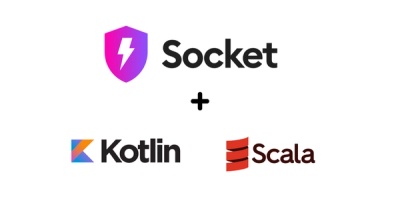
Product
Introducing Scala and Kotlin Support in Socket
Socket now supports Scala and Kotlin, bringing AI-powered threat detection to JVM projects with easy manifest generation and fast, accurate scans.
@pushprotocol/socket
Advanced tools
This package helps to connect to Push backend using Websockets built on top of [Socket.IO](https://socket.io/docs/v4/client-api/)
This package helps to connect to Push backend using Websockets built on top of Socket.IO
yarn add @pushprotocol/socket ethers
or
npm install @pushprotocol/socket ethers
Import in your file
import {
createSocketConnection,
EVENTS
} from '@pushprotocol/socket';
const pushSDKSocket = createSocketConnection({
user: 'eip155:5:0xab16a96d359ec26a11e2c2b3d8f8b8942d5bfcdb', // CAIP, see below
env: 'staging',
socketOptions: { autoConnect: false }
});
IMPORTANT: create the connection object in your app only when you have the user address available since its mandatory.
autoConnect: Generally if we don't pass autoConnect: false then the socket connection is automatic once the object is created. Now since we may or may not have the account address handy and wish to start the connection during instantiation so this option makes it easier for us to choose when we want to connect or not!
Allowed Options (params with * are mandatory)
| Param | Type | Default | Remarks |
|---|---|---|---|
| user* | string | - | user account address (CAIP) |
| env | string | 'prod' | API env - 'prod', 'staging', 'dev' |
| socketOptions | object | - | supports the same as SocketIO Options |
pushSDKSocket.connect();
pushSDKSocket.disconnect();
pushSDKSocket.on(EVENTS.CONNECT, () => {
});
pushSDKSocket.on(EVENTS.DISCONNECT, () => {
});
pushSDKSocket.on(EVENTS.USER_FEEDS, (feedItem) => {
// feedItem is the notification data when that notification was received
});
Supported EVENTS
| EVENT name | When is it triggered? |
|---|---|
| EVENTS.CONNECT | whenever the socket is connected |
| EVENTS.DISCONNECT | whenever the socket is disconneted |
| EVENTS.USER_FEEDS | whenever a new notification is received by the user after the last socket connection |
| EVENTS.USER_SPAM_FEEDS | whenever a new spam notification is received by the user after the last socket connection |
In any of the below methods (unless explicitly stated otherwise) we accept either -
CAIP format: for any on chain addresses We strongly recommend using this address format.
(Example : ETH MAINNET address will be like eip155:1:0xab16a96d359ec26a11e2c2b3d8f8b8942d5bfcdb)
ETH address format: only for backwards compatibility.
(Example: 0xab16a96d359ec26a11e2c2b3d8f8b8942d5bfcdb)
import { useState, useEffect } from "react";
import { createSocketConnection, EVENTS } from '@pushprotocol/socket';
const user = '0xD8634C39BBFd4033c0d3289C4515275102423681';
const chainId = 5;
const userCAIP = `eip155:${chainId}:${user}`;
function App() {
const [sdkSocket, setSDKSocket] = useState<any>(null);
const [isConnected, setIsConnected] = useState(sdkSocket?.connected);
const addSocketEvents = () => {
sdkSocket?.on(EVENTS.CONNECT, () => {
setIsConnected(true);
})
sdkSocket?.on(EVENTS.DISCONNECT, () => {
setIsConnected(false);
})
sdkSocket?.on(EVENTS.USER_FEEDS, (feedItem) => {
/**
* "feedItem" is the latest notification received
*/
console.log(feedItem);
})
};
const removeSocketEvents = () => {
sdkSocket?.off(EVENTS.CONNECT);
sdkSocket?.off(EVENTS.DISCONNECT);
};
const toggleConnection = () => {
if (sdkSocket?.connected) {
sdkSocket.disconnect();
} else {
sdkSocket.connect();
}
};
useEffect(() => {
if (sdkSocket) {
addSocketEvents();
}
return () => {
removeSocketEvents();
};
}, [sdkSocket]);
useEffect(() => {
const connectionObject = createSocketConnection({
user: userCAIP,
env: 'dev',
socketOptions: { autoConnect: false }
});
setSDKSocket(connectionObject);
return () => {
if (sdkSocket) {
sdkSocket.disconnect();
}
};
}, []);
return (
<div>
<h1>Socket Hello World</h1>
<div>
<p>Connection Status : {JSON.stringify(isConnected)}</p>
<button onClick={toggleConnection}>{isConnected ? 'disconnect' : 'connect'}</button>
</div>
</div>
);
}
export default App;
Please note connecting with sockets and maintaining the state of the connection object in your DAPP might have a different setup like first getting the user account and chainId and then connecting with socket. You can use React Context for state management.
FAQs
This package gives access to Push Protocol (Push Nodes) using Websockets built on top of [Socket.IO](https://socket.io/docs/v4/client-api/). Visit [Developer Docs](https://docs.push.org/developers) or [Push.org](https://push.org) to learn more.
The npm package @pushprotocol/socket receives a total of 41 weekly downloads. As such, @pushprotocol/socket popularity was classified as not popular.
We found that @pushprotocol/socket demonstrated a not healthy version release cadence and project activity because the last version was released a year ago. It has 1 open source maintainer collaborating on the project.
Did you know?

Socket for GitHub automatically highlights issues in each pull request and monitors the health of all your open source dependencies. Discover the contents of your packages and block harmful activity before you install or update your dependencies.

Product
Socket now supports Scala and Kotlin, bringing AI-powered threat detection to JVM projects with easy manifest generation and fast, accurate scans.

Application Security
/Security News
Socket CEO Feross Aboukhadijeh and a16z partner Joel de la Garza discuss vibe coding, AI-driven software development, and how the rise of LLMs, despite their risks, still points toward a more secure and innovative future.

Research
/Security News
Threat actors hijacked Toptal’s GitHub org, publishing npm packages with malicious payloads that steal tokens and attempt to wipe victim systems.